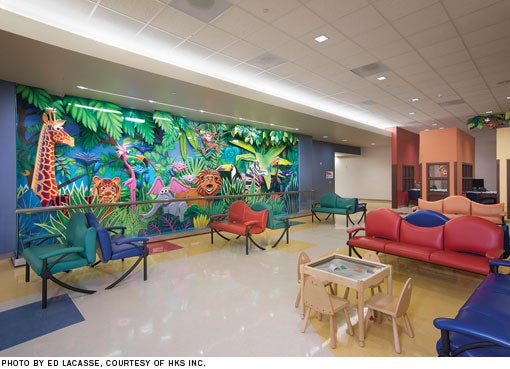Signs of change
About this articleThis feature is one of a series of quarterly articles published by Health Facilities Management magazine in partnership with the American Academy of Healthcare Interior Designers. |
Fifteen years ago, wayfinding as a holistic concept that includes directional signage, intuitive directional language, and audio and visual cues integrated into the design of the built environment was just starting to gain credence.
As a hierarchy of interconnected spaces, the health care built environment was then and remains now confusing to health facility users. Patients, caregivers, friends and family experience unnecessary stress and confusion in these settings. Hospital personnel also may spend too much valuable time guiding people.
Fortunately, health care facilities professionals today have embraced the importance of the art and science that includes wayfinding and collectively is known as "environmental graphic design."
Inside and out
Historically, the need for health care wayfinding was self-evident, but development and implementation of better methods of navigation often were unclear. Project signage was a line item on the budget but, too often, there was a noticeable disconnect among the interior signs, exterior signs and the corporate brand.
With every merger or acquisition, the exterior signs might have changed; yet, little was done to coordinate, manage and update the interior signage. Signage and graphic design elements were casualties in the battle between capital expenditures and operational expenses. For many health care facilities, a comprehensive wayfinding program was financially and logistically overwhelming, and generic signage seemed to be the only viable option.
A number of wayfinding design challenges stood in the way of advancing beyond this state of affairs. They included:
- understanding organizational priorities and getting key personnel to promote the design agenda;
- stopping often enough to estimate cost and avoid value engineering at the end of the process;
- shifting through the advice and directives that end users often provide, yet staying true to the scope of work;
- finding every creative tool available to help guide public movement subconsciously;
- getting the mock-up early enough to make important changes in a timely manner;
- developing a color palette that transcends time as much as possible;
- getting hospital marketing departments to understand that wayfinding begins with materials patients receive before they go to the facility;
- helping health care facilities identify a realistic budget and working within that budget.
As the health care landscape changed, however, hospital management began recognizing the importance of a coordinated marketing strategy. This strategy included branding efforts and the integration of both electronic and print information and site graphics. Integrated signage, art, kiosks and other directional resources such as valet services and cyber cafes were added. Designers developed and published works on healing environments and evidence-based design concepts.
What architects and interior designers already believed was now a proven fact. A solid case could be built that wayfinding matters significantly in terms of patient-centered care and improved patient satisfaction. Better design often embraced Lean design and good wayfinding programs improved the bottom line.
Moreover, health facilities professionals learned how to embed wayfinding principles into the architecture itself. The solution was no longer hanging more signs that too often confounded the visitors; but creating a graphic culture in which visitors and patients could intuitively navigate while experiencing beautiful objects and places along the path of journey.

Developing a system
As this challenge shifted, designers were expected to embrace evidential design, including the new science of wayfinding. Often a mock "patient journey" has been undertaken and some designers incorporate information learned through staying overnight in the facility as a part of the programming phase of their project.
It became extremely important to design space that could be recalled in a cognitive map. The list of "things not to do" grew and designers educated their clients about the value of wayfinding one project at a time. Signage manufacturers developed new systems that were more easily incorporated into a wayfinding strategy.
Of notable importance, designers took a leadership role in developing better solutions and worked more collaboratively with environmental graphic designers, art consultants and signage manufacturers. The uniform standard colors were replaced with bold and engaging shapes and styles. The text changed from predictable to a mixture of font styles and letter weights. Art, furniture and landscape materials were given their due place in the wayfinding solution.
This emphasis on collaboration has led to some key best practices. They include:
- providing current "as-built" plans for the wayfinding designer to develop the concept;
- budgeting enough time and money for the designer to become familiar with the organization's corporate culture, employees and patients;
- empowering the designer to be the creative force behind change;
- giving the organization clear communication that wayfinding is vital;
- instructing staff that they also are wayfinding tools and must understand the wayfinding system and the facilities in detail;
- changing the wayfinding program as often as the health care facility changes.
Wayfinding should be addressed early in the programmatic phase when users can be surveyed. Wayfinding nomenclature can be developed based on a hierarchy of information. For example, information should be developed that leads from point to point rather than confusing visitors with too much information, typical of directional flagpoles and directory floor plans. Most people can recall a landmark before they can recall a floor plan with a "You are here" spot. Wayfinding systems also should address language barriers and solutions that are landmark-based.
Walls, furniture and art can be embedded to be points of orientation. These models are useful solutions that address the rigors of the new Americans with Disabilities Act (ADA) standards that were revised and put into law in March 2011. Designers must have the knowledge or have a consulting partner to address the nuances of the ADA requirements. Good wayfinding systems incorporate good signage systems. The best meet minimum ADA guidelines and the recommendations of the Society for Environmental Graphic Design (www.segd.org).
Mapping software can help at every turn, giving designers opportunities to be language-friendly and accessible to the disabled. Mapping is available from a patient's home to the health care facility parking lot and, once there, many hospitals are equipped with interactive kiosks and app utilities that give directions in multiple languages.
Role of technology
Designers will need to find the most economical wayfinding solutions when designing for health care facilities. Machines generally work smarter and cheaper than people, so the industry likely will see a dramatic increase in wayfinding technology. In fact, this technology may become a portal to medical records, and patients actually will be developing their own triage file upon arrival at a hospital.
Imagine a time when patients assist caregivers by checking themselves in, accessing their insurance data, providing mandated notification to the insurer, stepping forward with technology in hand while their vitals are being taken and then moving through controlled spaces via their electronic pad, which synchronizes with the medical caregivers e-pad.
These tools provided by the health care facility automatically will integrate the patient's medical information regardless of spoken or written language. As interior spaces and uses of space change, these tools will be updated in the same way as current asset management tools.
Signage systems with easily adaptable computer chips will be favored. Technology will be developed so most signage is artificially illuminated by photosensitive chips that require little, if any, replacement. Much like small light-emitting diodes, the illumination alone will make the graphic colors lively and more easily read from a greater distance.
Technology is a friend to younger patients and family members; however, it is also a perceived enemy to older populations, particularly those who are sight-impaired. This has consequences for elderly populations and major implications for the larger boomer generation that will become the primary user of health care facilities.
Other challenges of technology include the potential loss of the personal touch. A front door valet and concierge greeter make visitors feel special. These same people will answer questions directly and even walk visitors to their destinations within the hospital. It is a brand action, an opportunity to be empathic. During a technology failure, visitors may be confused, frustrated and perhaps lost, but when wayfinding programs incorporate the human connection, they feel relieved.
With or without technology, navigation is a challenge for some and a captivating game for others. Designers need to consider all users, those who are not technologically inclined, as well as those who embrace technology. Buildings will get smarter and, hopefully, instincts will remain intact. Visitors need navigation support, not natural navigational replacement. Lastly, what role can exploration and discovery play as important distractions in the patient journey? Disney has made this into an art form where the journey and the experience are one, where waiting is limited and enjoyable.
Extending the brand
The logo, color, shape, texture and graphic symbol all help to define a brand image, but it is only when these design elements are consistently applied throughout the facility that the brand takes on life. There are countless ways to reuse corporate colors on floors, walls, ceilings and even the buildings' exterior to reinforce the health care organization's brand.
Ultimately, wayfinding is an extension of a health care organization's branding statement. Considering the value of branding, facility planners and designers will continue to spend even more effort and resources on wayfinding. When an organization comprehends and is able to communicate its truest essence, design teams can express the message and the value of the organization and its services to its clientele and its employees.
Dan Lee, AAHID, AIA, ASID, EDAC, is national design manager for Business Interiors by Staples and Chris Bauer is managing principal of focusEGD, Dallas. They are at dan.lee@staples.com and cbauer@focusegd.com.





